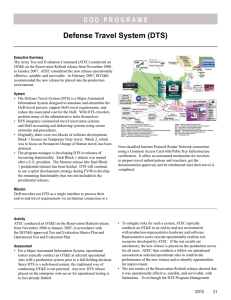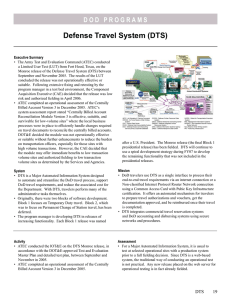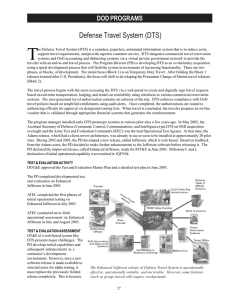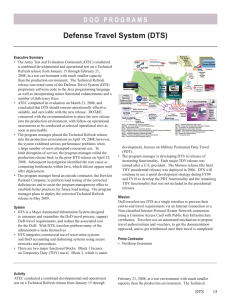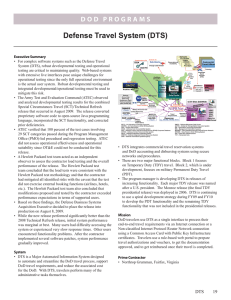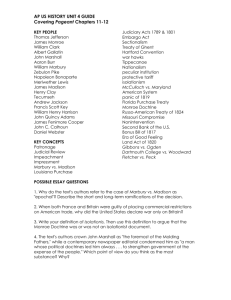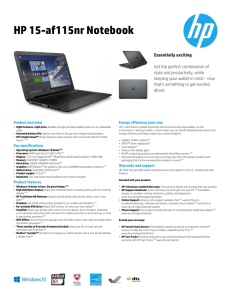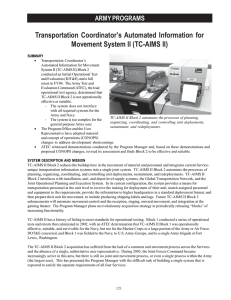Defense Travel System (DTS)
advertisement
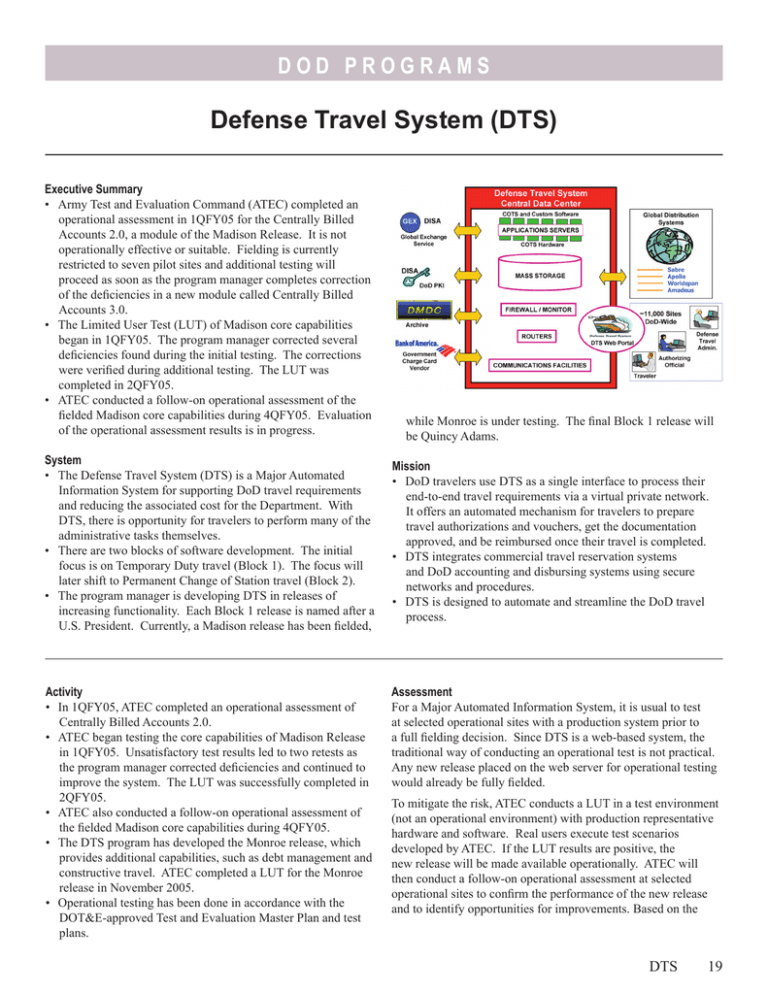
DOD PROGRAMS Defense Travel System (DTS) Executive Summary • Army Test and Evaluation Command (ATEC) completed an operational assessment in 1QFY05 for the Centrally Billed Accounts 2.0, a module of the Madison Release. It is not operationally effective or suitable. Fielding is currently restricted to seven pilot sites and additional testing will proceed as soon as the program manager completes correction of the deficiencies in a new module called Centrally Billed Accounts 3.0. • The Limited User Test (LUT) of Madison core capabilities began in 1QFY05. The program manager corrected several deficiencies found during the initial testing. The corrections were verified during additional testing. The LUT was completed in 2QFY05. • ATEC conducted a follow-on operational assessment of the fielded Madison core capabilities during 4QFY05. Evaluation of the operational assessment results is in progress. while Monroe is under testing. The final Block 1 release will be Quincy Adams. System • The Defense Travel System (DTS) is a Major Automated Information System for supporting DoD travel requirements and reducing the associated cost for the Department. With DTS, there is opportunity for travelers to perform many of the administrative tasks themselves. • There are two blocks of software development. The initial focus is on Temporary Duty travel (Block 1). The focus will later shift to Permanent Change of Station travel (Block 2). • The program manager is developing DTS in releases of increasing functionality. Each Block 1 release is named after a U.S. President. Currently, a Madison release has been fielded, Mission • DoD travelers use DTS as a single interface to process their end-to-end travel requirements via a virtual private network. It offers an automated mechanism for travelers to prepare travel authorizations and vouchers, get the documentation approved, and be reimbursed once their travel is completed. • DTS integrates commercial travel reservation systems and DoD accounting and disbursing systems using secure networks and procedures. • DTS is designed to automate and streamline the DoD travel process. Activity • In 1QFY05, ATEC completed an operational assessment of Centrally Billed Accounts 2.0. • ATEC began testing the core capabilities of Madison Release in 1QFY05. Unsatisfactory test results led to two retests as the program manager corrected deficiencies and continued to improve the system. The LUT was successfully completed in 2QFY05. • ATEC also conducted a follow-on operational assessment of the fielded Madison core capabilities during 4QFY05. • The DTS program has developed the Monroe release, which provides additional capabilities, such as debt management and constructive travel. ATEC completed a LUT for the Monroe release in November 2005. • Operational testing has been done in accordance with the DOT&E-approved Test and Evaluation Master Plan and test plans. Assessment For a Major Automated Information System, it is usual to test at selected operational sites with a production system prior to a full fielding decision. Since DTS is a web-based system, the traditional way of conducting an operational test is not practical. Any new release placed on the web server for operational testing would already be fully fielded. To mitigate the risk, ATEC conducts a LUT in a test environment (not an operational environment) with production representative hardware and software. Real users execute test scenarios developed by ATEC. If the LUT results are positive, the new release will be made available operationally. ATEC will then conduct a follow-on operational assessment at selected operational sites to confirm the performance of the new release and to identify opportunities for improvements. Based on the DTS 19 DOD PROGRAMS Madison LUT results, ATEC considered the release operationally effective, suitable, and survivable, but with deficiencies noted. We agreed to the installation of the new Madison release for an in-field operational assessment. The operational assessment data collection was completed, but data analysis is still ongoing. Although DTS worked satisfactorily with most of its many interfacing accounting and disbursing systems, there was an anomaly with the legacy Washington Headquarters Services Allotment Accounting Systems, which caused delay in processing some of the DTS transactions. Although this problem was subsequently fixed by the maintenance staff of the legacy accounting systems, these systems were not available to process FY06 transactions for the first two weeks of the new fiscal year. Any problem such as this requires implementing workarounds and confuses those travelers that have to use DTS interfacing with these legacy systems. The Centrally Billed Accounts 2.0 module of Madison is neither operationally effective nor suitable. The credit card reconciliation process is not prompt and there are certain interoperability and business process deficiencies, such as 20 DTS occasional non-receipt of charge card vendor invoices and cumbersome manual reconciliation processes. The Monroe release is not operationally effective or suitable, but is survivable. There are many faulty cost computations on obligations, vouchers, debt resolutions, cost entitlements, remittances, waivers, and payroll deductions, which led to many data exchange rejections by interfacing systems. Recommendations 1. The Centrally Billed Accounts 2.0 module should not be fielded past the pilot sites until the program manager corrects the deficiencies and the fixes are verified by ATEC. 2. The Monroe release should not be fielded until the program manager corrects the deficiencies and ATEC retests the release. 2. The Monroe release operational assessment should include the legacy accounting system to avoid problems that were experienced in the past. 3. Fix or replace the legacy Washington Headquarters Services Allotment Accounting System. This responsibility is with the owner of this legacy system versus the DTS program manager.
